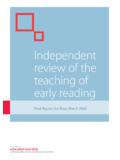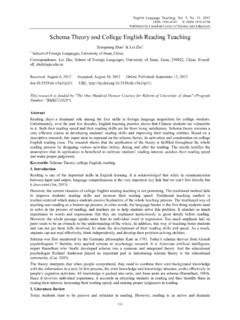Transcription of Physical Theatre: Approaches to teaching in the style of ...
1 1 teaching Drama Summer term 1 2017 overall aim of this scheme of work is to explore a Physical theatre style by introducing students to the work of Frantic Assembly, and to encourage learners to try out techniques and practical starting points to help them create short devised can be difficult for students who have never devised their own work before to create original and thought-provoking pieces, especially in Year 9. It is also a challenge to create scripted work as they will have a limited experience of this. This is why I think a more Physical approach to creating pieces, without having to think about how to develop characters and storylines initially, can work really you may not think the work of Frantic Assembly would be approachable for students as young as Year 9, it is amazing how quickly they get to grips with the style .
2 It is also a good preparation for upcoming GCSE courses, as an increasing number of exam boards are prescribing styles for devised and text work at students work develops, stories emerge and meaning is created. They learn to take a practical on their feet approach to the creation of work and I have found that some interesting and mature work has been produced as a result much more so than if they had been asked to create something in a naturalistic style , as at this young age their pieces can be quite they have never seen a production by Frantic Assembly, it is important that you show them lots of show reels and trailers of their work, so that they start to understand what the result looks like, and so that they can get a flavour of what the style looks like on stage. I have therefore provided many links to video extracts in this scheme, and most lessons will include a video example to show to students before they attempt an exercise for scheme covers six lessons of teaching .
3 I have based the structure around the principle of one lesson a week, with each lesson being around an hour in objectives for the schemeBy the end of this scheme of work, students will have a deeper understanding of modern Physical theatre within the context of a contemporary company, focusing on the style of Frantic Assembly. They will be familiar with some of their work and have tried out techniques for themselves. Learners will explore a range of practical exercises in order to start developing ideas and Approaches to short devised fFrantic Assembly website fThe Frantic Assembly Book of Devising Theatre by Scott Graham and Steven Hoggett (ISBN: 1-138-77701-3) fYouTube clips of their shows links detailed in the scheme fBlocks or chairs fScrap paper fA wide range of music (some track suggestions are listed in this scheme, but you can use whatever you enjoy and think works with your class they might suggest some great choices as well!)
4 FDVD of Black Watch by The National Theatre of Scotland. Available on Amazon: +watch+dvd (Please note the rating for this show is 18, but this scheme only uses clips with music and no dialogue, therefore the content is appropriate for this age group.)Assessment fPeer assessment assessing the outcome of sections of performed work in class. fFilmed assessment this is a great way for students to review their work and analyse the stories starting to develop within their Holcombe is a Drama teacher and Head of Year 8 at Queen Elizabeth s Hospital school in Bristol. She has been teaching and directing Theatre for 11 years in both the maintained and private school Theatre: Approaches to teaching in the style of Frantic AssemblyNaomi HolcombeKS32 teaching Drama Summer term 1 2017 of work|KS3 Research/HomeworkAt the end of the first lesson, make sure students are set a homework or research task on Frantic Assembly.
5 Encourage them to access their website, watch trailers and explore music. This will all help students to access the work more 1: How to devise theatreOutcomes: Creating content for a piece of devised theatre through objectivesBy the end of this lesson students will have: fUsed a range of movement exercises to create a sequence fDeveloped the sequence into a short piece of devised movement and started to create meaning fUsed music, pace and emotions to play around with meaning and develop storylines fStarted to explore a more Physical way of working and to appreciate how many modern theatre companies take this sort of no. 1: Push HandsThis is an exercise created by Scott Graham and Steven Hoggett. It can be found in The Frantic Assembly Book of Devising Theatre. There is also a video example of this in the Learning how to fly video, created for The Curious Incident of the Dog in the Night-Time; it can be found here: exercise is 40 seconds into the pairs, one person has their palm facing down towards the floor, the other person puts their hand underneath, facing up.
6 The person with their hand underneath adds pressure going upwards and the person on top pushes down to create some tension. The person with their hand on top is leading and must move together with their partner around the levels and pace. If some pairs are particularly confident with this, they can move to the next step, which is for the person whose hand is underneath, to close their eyes and focus solely on the no. 2: Sequencing movesIn a circle, standing up, ask students to stand with feet together, explain that they are going to move their feet to one rhythm/action and their arms to another; then they will put the two together to create a sequence. (This is not a Frantic Assembly exercise, but is a good way of getting students to connect their bodies and brains together!)First, feet. The right leg goes forward on the count of 1; to the side on the count of 2; then back together on 3.
7 Repeat the same process with the left leg. So they have 1, 2, 3 with the right foot, then switch to 1, 2, 3 with the left; forwards, out, together. Then the arms: both arms go out to the front on the count of 1, up above their heads on 2, out to the side on 3, then back down by their sides on 4. So the arms go in a pattern of 4 counts and the legs on 3 counts. Now put the two together! Model this first then encourage students to have a go for themselves. It is tricky!Discussion: Why was this difficult? What is muscle memory? Why do you think it is that after a while, your body can learn the sequence? Move the discussion onto Physical styles of theatre. Ask why they think that some modern theatre companies take a Physical approach to their work first, before developing the script? Has anyone seen any theatre which features a lot of movement?
8 Task 1: Sensory memory exerciseFollowing on from warm-up no. 2, students are going to create a sequence of 10 moves to learn. This is based on the exercise Hymn Hands which can be found in The Frantic Assembly Book of Devising Theatre and is a slightly simplified version of this exercise. A video example of it can be found here: (5 mins 50 secs into the video).Facing a partner, decide who is going to go first. The person going first has two choices: put their hand on their partner (stick to the upper body and make the moves very simple, such as a hand on the shoulder) or put their hand on themselves. Once they have done this, the other person in the pair now has three choices: put their hand on their partner, put their hand on themselves, or remove the hand from themselves or from their partner. They should now have two moves.
9 They continue, until they have a sequence of 10 moves all may take you longer than one lesson, so feel free to run this into two lessons if you want to spend more time on each Drama Summer term 1 2017 of work|KS3 Give students some time to create their sequence, then ask them to repeat it and loop it until it becomes muscle memory. Watch a few of these halfway through this s k 2 Now ask students to think about making the moves more interesting, by perhaps adding in a turn, moving their hand from one shoulder to another whilst their partner ducks their head, or switching places during the sequence. Give them a bit more time to adjust their sequences a little. You can show the video example again here to give them s k 3 They are going to develop these sequences into a short piece of theatre. They are not going to add in characters or a storyline, but ask them to vary the pace.
10 Encourage them to run the entire sequence through very quickly, or try the whole of it slowed down, or just a particular move slowed down. Experiment with pace and see which version they like the they are rehearsing, play some music in the background. Play two different tracks, one fast and one slower. I like to use something like Basement Jaxx Where s your head at as it s really upbeat and gets them moving. For a slower track, Nihls Frahm s Corn is beautiful (this was used in Frantic Assembly s production of Things I Know to be True) or Massive Attack s Teardrop is also very they have rehearsed for enough time to feel confident and have looped their sequence at least twice, ask them to decide on the pace and which piece of music they would like to perform the class up into the groups that prefer the fast track and those who want the slower piece of them pair by pair, back to back fast track first, then have a discussion, then ask the groups with the slower track to perform students, while they are watching other pairs, to see if any sort of story starts to emerge.







